This post may contain affiliate links. Please see our disclosure policy.
White currant jelly is an easy homemade preserve that comes together in minutes with just two ingredients. It may well be the quickest and easiest way to preserve white currants when harvests are more than you can enjoy fresh.
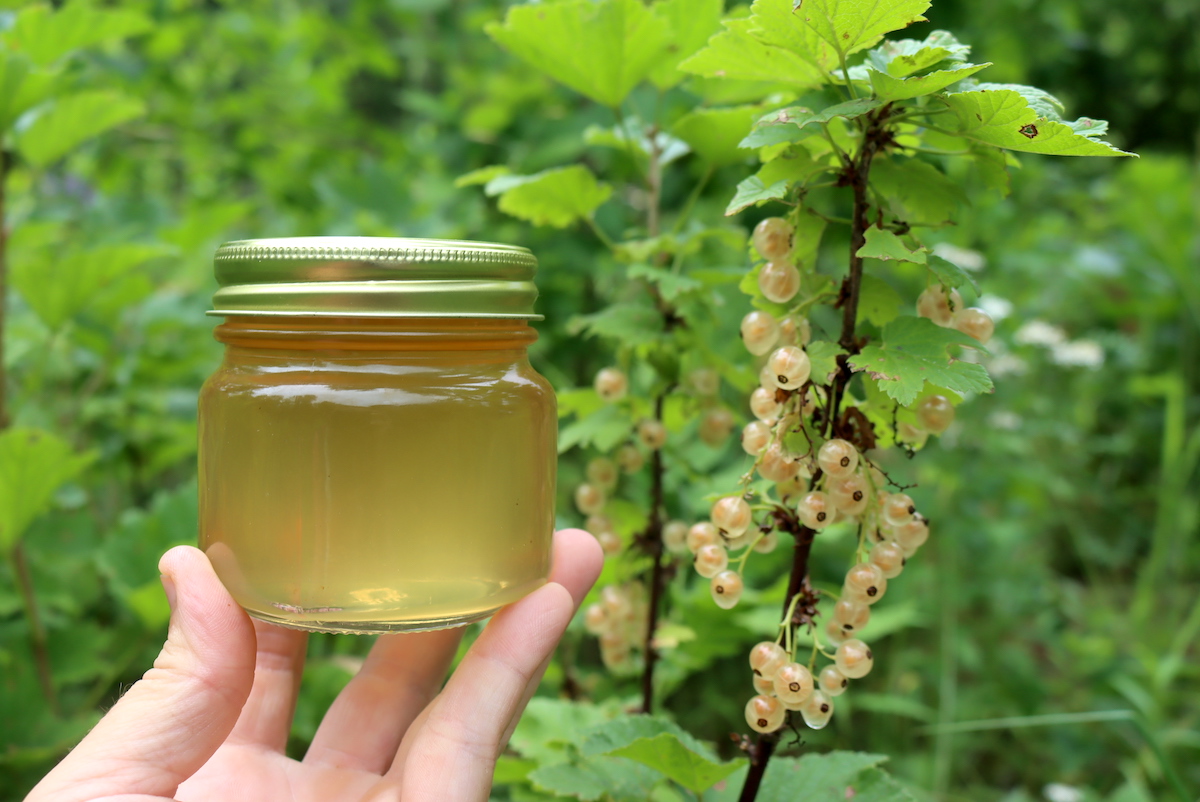
Our shady wet land on our woodland homestead is well suited to growing currants, and we always have big crops of both black currants and red currants. I turn them into blackcurrant jam and blackcurrant jelly, as well was redcurrant jam and redcurrant jelly every single year.
A few years ago we added white currants to our gardens, largely so I’d be able to enjoy even more color in my midsummer harvest basket each year. For the first few years, the plants were small and we only harvested a handful each season.
The plants are now quite large, and we’re pulling in good sized harvests. It’s time to add white currant jelly to my homemade preserves list!

Ingredients for White Currant Jelly
I’ve kept this recipe very small (but can be increased up to 4x), as often you’re only able to harvest just a little bit of fresh fruit unless you have a lot of homegrown white currants.
If you’re buying them in baskets from the farmers market, they generally come in half pint (1 cup) or pint (2 cup) sizes. You need around 1 1/4 to 1 1/2 cups of fresh white currants to make a single 8 oz jar of jelly, so go for a full pint so you can snack on them for a bit before you make the jelly.
To make one jar of white currant jelly, you’ll need:
- 1/2 pound (225 g) white currants, about 1.5 cups
- 1/4 cup water
- 1 cup sugar
The currants are cooked with the water until they release their juices. This amount should yield right about 1 cup of white currant juice. Sugar is added in a 1:1 ratio to make white currant jelly, so measure the juice.
If your yield is anything like mine, you’ll then need 1 cup of sugar. Be sure to measure the resulting juice though, if you get more juice, you’ll need more sugar (and less sugar for less juice).
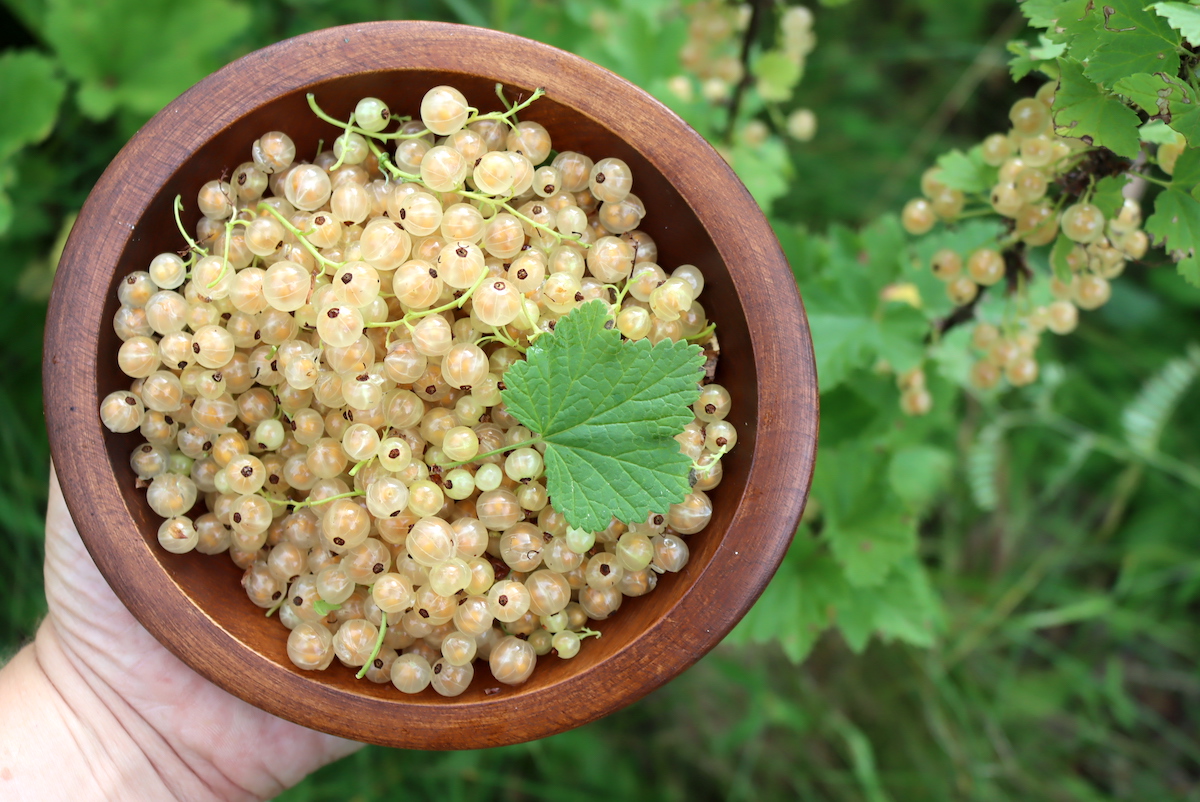
How to Make White Currant Jelly
Start by bringing the white currants to a boil with a small amount of water. You’ll want about 1/4 cup of water for every 1/2 pound (1 1/2 cups) of fresh white currants.
If the currants aren’t stemmed, don’t bother. The stems will be filtered out when you strain the juice, and they’re actually really full of natural pectin. Leaving the stems in while you extract the juice will actually help your jelly set.
It should take about 3 to 5 minutes of gentle simmering for the currants to fall apart and release their juices, and you’ll need to mash them a bit with a spatula to help the process along.
Strain the fruit through a jelly bag or a double layer of dampened cheesecloth.
For every 1/2 pound of fruit (1 1/2 cups), you should get about 1 cup of juice. Measure the juice, as it determines how much sugar you’ll need.
Place the strained juice back into a saucepan and add equal parts sugar. In this case, if you had 1 cup juice, you’ll add 1 cup sugar.
Stir to dissolve the sugar and turn the heat up to high. Bring it to a full rolling boil, and cook the mixture until it reaches gel stage, which is 220 degrees F measured on an instant read thermometer.
You can also test for set on a plate that’s been placed in the freezer.
When the jelly reaches gel stage, remove it from the heat and ladle into prepared jars.
This jelly takes about 48 hours (or more) to fully set in the jars, so be patient. If it’s not set as soon as it cools, just wait a while. Natural jellies like this can take as long as a week to fully set in the jar.
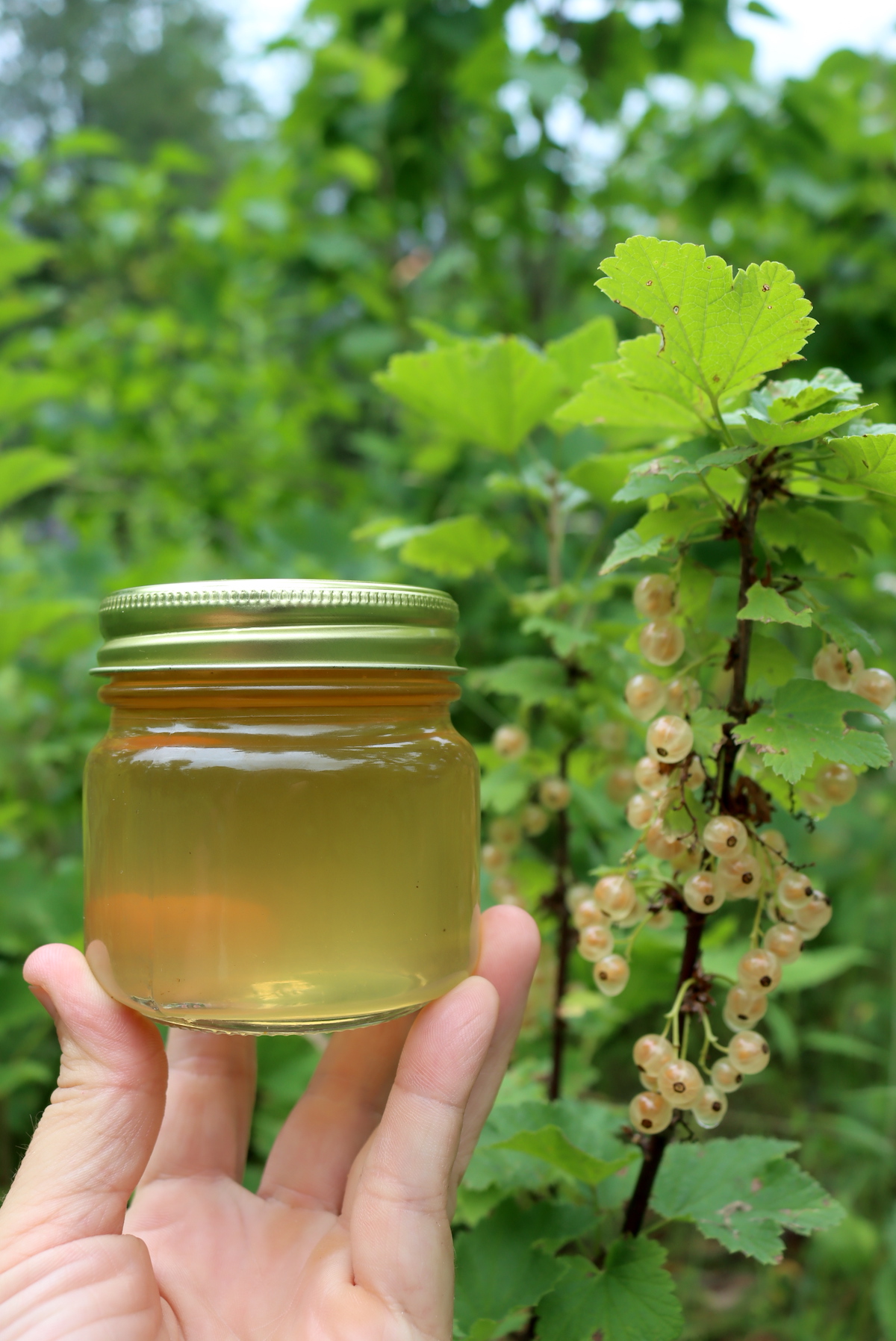
White Currant Jelly Batch Size
It’s perfectly fine to increase this recipe to get a full batch, instead of a single jar. With 1 1/2 cups fruit, you should get slightly over 1 jar of jelly, or about 1 1/4 jars of finished jelly. Multiplying the recipe by 4 and starting with 6 lbs of fruit should yield about 5 jelly jars.
That’d be 6 lbs of fruit and 1 cup water, cooked together for a few minutes and then strained. That should yield 4 cups juice.
Add in 4 cups sugar and cook to gel stage.
You should then have right about 5 jars of jelly.
(Don’t increase the batch size more than 6 to 8 lbs of fruit at a time. Really large batch sizes of jelly don’t cook evenly and may have trouble setting properly.)
Canning White Currant Jelly
White currants have plenty of natural acidity and they’re perfectly safe for canning. That’s no the case with all white fruits, and some fruits, like white peaches, cannot be used when making peach jam.
Canning is optional, but it does ensure that your white currant jelly is ready to use on the pantry shelf all year long. As a refrigerator jelly, this will keep a few weeks. In the freezer, it’ll keep up to 6 months, but natural jellies tend to lose their set a bit in the freezer as freezing damages natural pectins.
Personally, I always opt for canning because my goal is preserving the fruits of summer to enjoy during our long Vermont winter.
To can white currant jelly, prepare a water bath canner and bring it up to simmering (180 F) before you begin cooking your jelly. Prepare jars and lids too.
When the jelly reaches its set point, fill jars leaving 1/4 inch headspace and seal with 2 part canning lids. Use a jar lifter to load the jars into the canner and process the jars for 10 minutes (below 6,000 feet in elevation).
If you’re above 6,000 feet in elevation, increase the processing time to 15 minutes.
Once the processing time is complete, turn off the heat and allow the jars to sit in the canner for an additional 5 mintues to start to cool slightly. Then, use a jar lifter to unload the canner and place the jars on a towel on the counter to cool completely.
Check for seals after 12-24 hours, and store any unsealed jars in the refrigerator for immediate use.
White currant jelly takes a while to set, and don’t worry if it’s still not quite set 48 hours after you make it. It can take up to a full week to set in the jars.
(If it’s not set after a week, you can try re-cooking it. If you follow this recipe, use the right amount of sugar and cook to 220 degrees, you shouldn’t have any trouble getting it to set.)
Currant Canning Recipes
Currant Canning Recipes
Red Currant Jelly
Currant Canning Recipes
Canning Currant Pie Filling
Apricot Canning Recipes
Apricot Red Currant Jam
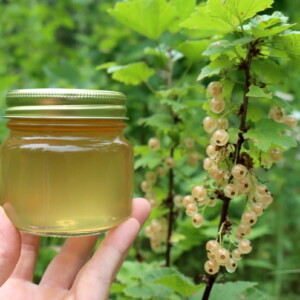
White Currant Jelly
Equipment
Ingredients
- 1 cup white currant juice, from 1/2 pound (225 g white currants, about 1.5 cups and 1/4 cup water)
- 1 cup sugar
Instructions
Making White Currant Juice for Jelly
- To make the white currant juice, place the white currants in a saucepan with 1/4 cup water for every half pound (or 1 1/2 cups) of fruit. Stemming is optional, but not required.
- Bring the mixture to a gentle simmer, mashing to encourage the fruit to release their juice. Cook for 2-5 minutes, until the fruit fall apart.
- Strain through a jelly bag or double layer of dampened cheesecloth. Measure the resulting juice. You should have 1 cup for every 1/2 pound of fruit.
Making White Currant Jelly
- If canning, prepare a water bath canner, jars and lids before beginning. (optional)
- Place the measured juice into a saucepan and add an equal amount of sugar by volume. (If you have 1 cup juice, add 1 cup sugar.)
- Bring the juice and sugar to a boil and cook over medium high heat until the mixture reaches gel stage (220 F when measured with an instant read thermometer). This should happen fairly quickly, in around 5 to 10 minutes. You can also test for set using a plate that's been chilled in the freezer.
- Once the jelly reaches its set point, remove it from the heat and ladle into prepared jars leaving 1/4 inch headspace. Cap with 2 part lids.
- If canning, process in a water bath canner for 10 mintues. Increase the processing time to 15 minutes if above 6,000 feet in elevation. Remove the jars from the canner and allow them to cool on a towel on the counter. Check seals after 24 hours and store any unsealed jars in the refrigerator for immediate use. Properly canned and sealed jars will keep on the pantry shelf for 12 to 18 months, refrigerate after opening.
Notes
Batch Size
This recipe can be increased up to 4 times, meaning you'd use 6 lbs of fruit. With 1 1/2 cups fruit, you should get slightly over 1 jar of jelly, or about 1 1/4 jars of finished jelly. Multiplying the recipe by 4 and starting with 6 lbs of fruit should yield about 5 jelly jars. That'd be 6 lbs of fruit and 1 cup water, cooked together for a few minutes and then strained. That should yield 4 cups juice. Add in 4 cups sugar and cook to gel stage. You should then have right about 5 jars of jelly. (Don't increase the batch size more than 6 to 8 lbs of fruit at a time. Really large batch sizes of jelly don't cook evenly and may have trouble setting properly.)Jelly Set
White currant jelly takes a while to set, and don't worry if it's still not quite set 48 hours after you make it. It can take up to a full week to set in the jars. (If it's not set after a week, you can try re-cooking it. If you follow this recipe, don't increase the batch size over 4 cups juice, use the right amount of sugar and cook to 220 degrees, you shouldn't have any trouble getting it to set.)Nutrition
Nutrition information is automatically calculated, so should only be used as an approximation.
Summer Jelly Recipes
Looking for more quick and easy jelly recipes to make this summer?
- Seedless Black Raspberry Jelly
- Old Fashioned Corn Cob Jelly
- Wild Grape Jelly
- Gooseberry Jelly
- Red Currant Jelly
- How to Make Floral Jelly (with Edible Flowers)
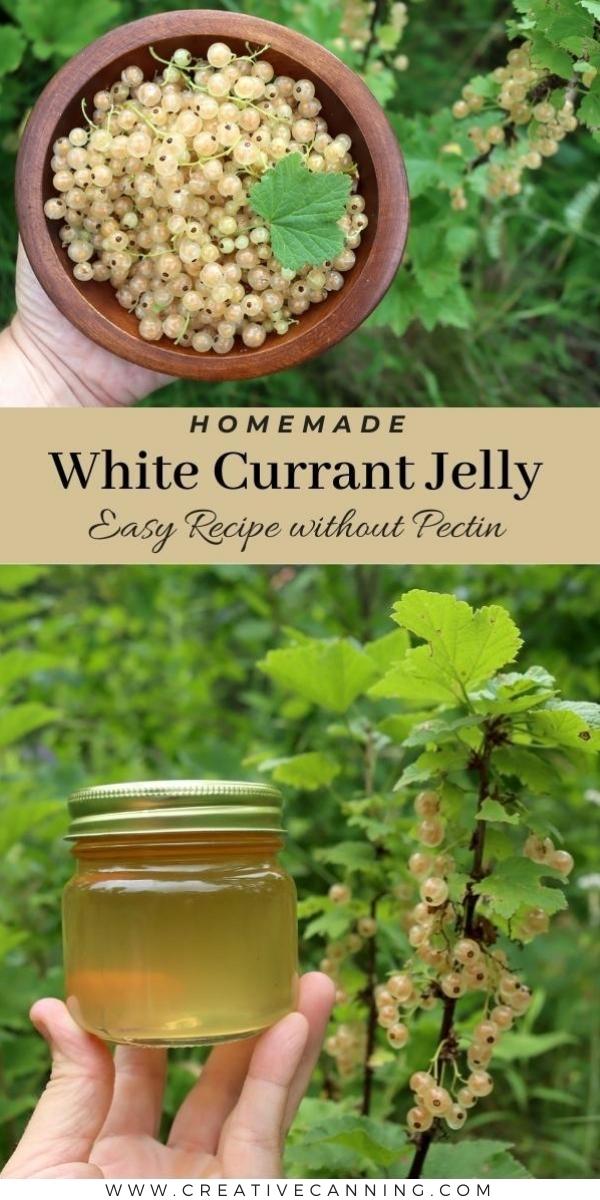

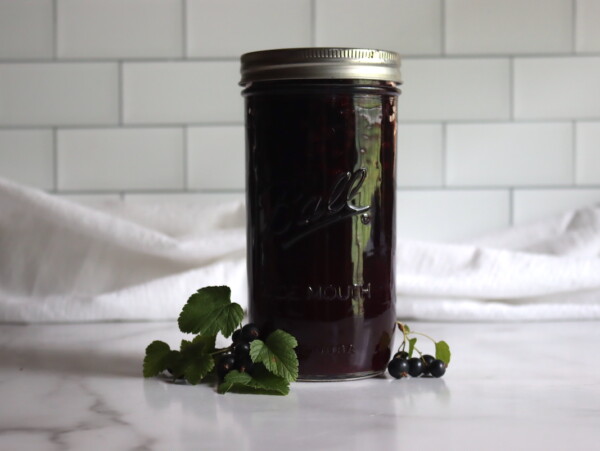
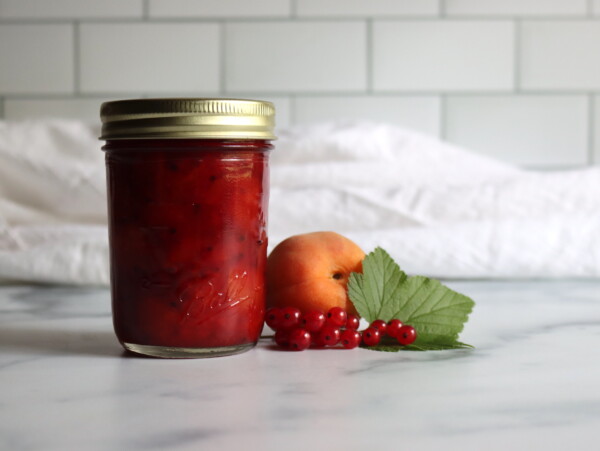
Great recipe and the easiest jelly I’ve ever made.
Wonderful! They really do have plenty of pectin, so this one comes together pretty readily. So glad you enjoyed it!
I tried making this with 6 cups of black currants. I heated them up with water and mashed them with a potato masher. I then poured it all into a jelly bag to strain overnight. I have only got about 1 cup of juice in my bowl. Not sure what I did wrong.
Black currants have a lot less juice and a lot more pectin than white currants. The juice yield is much lower. They also hold together more thoroughly, and need to be simmered with water for about 20 minutes to fully break down. (And a good bit of water too). When simmered long enough, and with a cup of water to every 3ish cups of fruit, you should get about 2 cups of juice from 6 cups of black currants (or at least that’s what I got this week from them). The yield is MUCH better if you use a steam juicer.
Anyhow, my point here is that black currants are a very different fruit that white currants, and they cook differently and have different amounts of juice and pectin. Here is my recipe for black currant jelly: https://practicalselfreliance.com/blackcurrant-jelly/